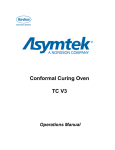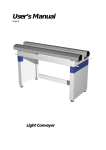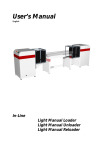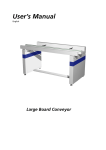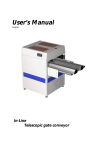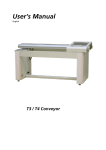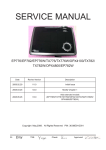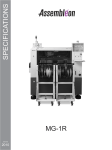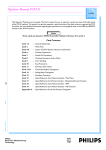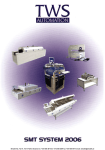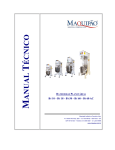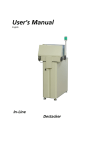Download User`s Manual
Transcript
User’s Manual English In-Line Board transfer system User´s Manual This manual is intended for the inline device specified on the previous page. The manual contains information to assist the operator to start and operate the device properly, and to maintain it. Hardware and software mentioned in this document are subjected to continuous development and improvement. Consequently, there may be minor discrepancies between the information in the document and the performance and design of the hardware and software. Specifications, dimensions and other statements mentioned in this document are subject to change without prior notice. Manufacturer and its suppliers shall not be liable for any damages related to the software or hardware, or for any other damages whatsoever caused of the use of or inability to use any manufacturer product. This is applicable even if manufacturer has been advised of the damage risk. Under any circumstances, manufacturer’s entire liability shall be limited to replace such defective software or hardware which was originally purchased from manufacturer. Printed in Sweden. ep776_020305u_eng.doc/ 2002-03-28 2 User´s Manual Contents 1. S A F E T Y . . . . . . . . . . . . . . . . . . . . . . . . . . . . . . . .. . . . . . . . . . . . . . . . . . . . . . . . . . . . . . . .. . . . . . . . . . . . . . . . . . . . . 4 Emergency stop ........................................................................................................5 Warning signs .......................................................................................................... 6 Warnings ................................................................................................................. 7 Noise........................................................................................................................7 2. ABOUT THE DOCUMENTAT I O N . . . . . . . . . . . . . . . . . . . . . . . . . . . . . . . . . . . . . . . . . . . . . . . . . . . 8 User's manual........................................................................................................... 8 3. I N S T A L L A T I O N . . . . . . . . . . . . . . . . . . . . . . . . . . . . . . . . . . . . . . . . . . . . . . . . . . . . . . . . . . . . . . . .. . . . . . . . . . 9 4. P R O D U C T D E S C R I P T I O N . . . . . . . . . . . . . . . . . . . . . . . . . . . . . . . .. . . . . . . . . . . . . . . . . . . . . . . . . . . 1 1 Controls and indicators.......................................................................................... 12 5. O P E R A T I O N . . . . . . . . . . . . . . . . . . . . . . . . . . . . . . . .. . . . . . . . . . . . . . . . . . . . . . . . . . . . . . . . . . . . . . . . . . . . . 1 5 Setting up the machine for operation..................................................................... 15 Alarms ................................................................................................................... 15 Alarm table ............................................................................................................ 16 Time adjustment .................................................................................................... 16 6. MAINTENANCE . . . . . . . . . . . . . . . . . . . . . . . . . . . . . . . . . . . . . . . . . . . . . . . . . . . . . . . . . . . . . . . . . . . . . . . . 1 7 Maintenance schedule ............................................................................................ 17 Cleaning ................................................................................................................ 17 Lubrication ............................................................................................................ 18 Lubricant specification ........................................................................................... 19 7. SERVICE . . . . . . . . . . . . . . . . . . . . . . . . . . . . . . . . . . . . . . . . . . . . . . . . . . . . . . . . . . . . . . . . . . . . . . . . . . . . . . . . . . 2 0 Exchange of conveyor belt ..................................................................................... 20 Exchange of belt rollers .......................................................................................... 20 Figures Figure Figure Figure Figure Figure Figure Figure Figure Figure 1-1 Electric shock ............................................................................................... 6 1-2 Moving parts................................................................................................ 6 1-3 Attention ..................................................................................................... 7 4-1 Main parts.................................................................................................. 11 4-2 Control panel............................................................................................. 12 5-1 Trimmer setup............................................................................................ 16 6-1 Lubricate the threaded rod ......................................................................... 18 6-2 Lubricate long linear bar............................................................................. 18 7-1 Belt roller ................................................................................................... 20 ep776_020305u_eng.doc/ 2002-03-28 3 User´s Manual 1. Safety Before starting the machine, it is essential that the operator, the foreman, and any other personnel involved in the machine operation understand the following points: • The machine must be operated by trained personnel only. • Anyone operating this machine must obey all warning signs. See the section entitled Warning Signs in this chapter. • All personnel involved in machine operation must understand the use of the emergency stop button and how to move machine elements in an emergency. See the following sections entitled Emergency Stop. • Do not use chemicals or other substances, which may have any influence on the operator or other personnel involved in the machine operation. • Apart from weekly, monthly and yearly maintenance as described in the Maintenance chapter of the User's Manual, the machine is to be serviced by authorized personnel only. • All covers and shields must be intact, mounted and closed while the machine is in operation. • Do not disable or disengage any built-in safety switches or sensors. • No hands or fingers are allowed near the moving parts of the machine. ep776_020305u_eng.doc/ 2002-03-28 4 User´s Manual Emergency stop There are two emergency stop buttons. One on top of each ‘tower’. If an emergency stop button is pushed (activated), all machine movements are stopped immediately and the pneumatic cylinder for the shuttle conveyor movement is depressurised. The emergency stop button has to be pulled up to enable restart of the machine after an emergency stop. The machine must always be switched off when hands, fingers, tools or other objects are in the danger area of movable machine elements. Emergency movement of machine elements If an accident has occurred and an emergency movement of the shuttle conveyor is required, use the following procedure: 1 . Push (activate) the emergency stop button or press the red stop button on the control panel. 2 . Push or pull the shuttle conveyor sideways and remove jammed objects. Manual movement of the shuttle conveyor should only be performed in an emergency situation. Manual mechanical movement can result in machine-part damage. ep776_020305u_eng.doc/ 2002-03-28 5 User´s Manual Warning signs The signs must be kept clean and readable. If a sign is missing, it must be replaced immediately. High Voltage The sign warns of electric shock. Units on which this sign is placed contain dangerous voltage levels. Power must be switched off before opening the unit. Only authorized service personnel are allowed to operate the machine when the unit is open. Figure 1-1 Electric shock This sign is applied as follows. • One sign on the cover over the electrical cabinet. Moving parts The sign warns of moving machine parts. Units on which this sign is placed contain moving machine parts. Power must be switched off before maintenance, service or opening the unit. Only authorized service personnel are allowed to operate the machine when the unit is open. Figure 1-2 Moving parts This sign is applied as follows. • One sign on each infeed/outfeed cover. Do NOT try to remove a jammed board while the power is on. ep776_020305u_eng.doc/ 2002-03-28 6 User´s Manual Warnings Throughout the manual this symbol is used to call your attention when a task is about to be performed, that could be harmful to personnel or damage the machine. The symbol often refers to the warning signs, which must be obeyed to eliminate the risk of injury. If there are instructions accompanying this symbol, they must be followed. Figure 1-3 Attention Noise The machine noise is considerably less than 70 dB(A). ep776_020305u_eng.doc/ 2002-03-28 7 User´s Manual 2. About The Documentation User's manual The User's Manual contains information to assist the operator to start and operate the machine properly. The Operator's Manual is divided into the following main parts: Chapter l: Safety instructions. C h a p t e r 2 : Information about the documentation. C h a p t e r 3 : Installation instructions. C h a p t e r 4 : Description of the machine and its basic operation. C h a p t e r 5 : Operational information for production. C h a p t e r 6 : Maintenance instructions. Chapter 7: ep776_020305u_eng.doc/ 2002-03-28 Service instructions. 8 User´s Manual 3. Installation Delivery The machine is delivered fixed on a pallet. Preparation Before the installation, prepare the location so, that electric power and pressurized air is available. Ambient conditions The ambient air must be clean. Allowed humidity: 0 to 35'C 10 to 90 % noncondensing 35 to 60'C 10 to 60 % noncondensing Allowed temperature: Operating 5 to 40 'C (41 to 104 'F) Storage -40 to 60 'C (-40 to 104 'F) Technical data Length contract. See specification included in the Voltage 90-240 VAC Frequency 50/60 Hz Power consumption max. 300 W PCB Length PCB Width PCB Thickness 50-450 mm (2 - 17.7”) 50-360 mm (2 - 14.2”) 50-508 mm (2 - 20”) 0.8-4 mm (0.03 – 0.2) PCB weight max. 3 kg (6.6 lbs) The machine can be lifted with one forklift under each ‘tower’. Put some wooden boards between the forks and the frame parts before lifting. ep776_020305u_eng.doc/ 2002-03-28 9 User´s Manual I ns t a l l a t i o n The installation must be carried out by authorized service personnel. The complete machine line must be carefully levelled along the shuttle conveyors belts. Use a spirit level across and along the machines belts when adjusting the feets of the machine. The fundament must be rigid and sturdy. The machine must not rock. The machine must be placed in a manner that allows access to all parts of the machine and so that service actions are not obstructed. There must be a free space of one meter around the machine, except for the other machines included in the production line. Mains supply Must be connected by an authorized electrician. ep776_020305u_eng.doc/ 2002-03-28 10 User´s Manual 4. Product Description Overview The Board transfer system consists of a solid steel framework and a shuttle conveyor. It is also equipped with a control panel and an electrical cabinet. One or two photo sensors (board sensors) are positioned on the shuttle conveyor. A B C B D E F G H Figure 4-1 Main parts A . Status indicators (Light tower) B . Emergency stop buttons C. Tower 2 D. Conveyor tunnel E . Control panel F . Tower 1 G. Electrical cabinet. (Behind the cover plate, on the opposite side) H. Connectors for air supply, Safety loop and SMEMA (Behind the cover plate) ep776_020305u_eng.doc/ 2002-03-28 11 User´s Manual Function The Board transfer system (BTS) transfers boards sideways, a customer defined distance. When there is a board on an upstream machine the BTS receives a signal that says board available. If the shuttle conveyor is empty, it moves to the infeed position (if not already there). The BTS sends back a ready signal and the board is transported onto the conveyor. The shuttle conveyor then moves to the outfeed position and awaits a ready to receive signal from the downstream machine. When that signal comes, the board is transported out from the conveyor and the shuttle conveyor moves back to infeed position to receive the next board. Controls and indicators Control panel A B C D E Figure 4-2 Control panel A . Stop button B . Start button C. Reset button D. Width mode selector (Option) E . Widthadjustment switch ep776_020305u_eng.doc/ 2002-03-28 12 User´s Manual Start button : Press this button to start the machine. If the green status indicator is lit, the machine is started. Note: If the machine does not start when the Start button is pressed, check/do the following: 1. Press Reset button, then press Start button. 2. Press and hold Reset button for 5 seconds, then press Start button. 3. Is any emergency stop button activated? 4. Is the ‘Safety loop’ connected correctly? Stop button : Press this button to stop the machine. All machine part movements are stopped, the pneumatic cylinder is depressurised and the green status indicator is turned off. Reset button : Press this button to reset a shuttle timeout, infeed timeout or outfeed timeout. Press and hold this button for five seconds to reset ‘Board on conveyor’. A reset of ‘Board on conveyor’ is confirmed by alternated flashing of the red and green status indicator. Width mode selector (Option) : Select desired widthadjustment mode. Manual: Manual widthadjustment is selected. Auto: Automatic widthadjustment is selected. See separate document for detailed information on Automatic widthadjustment. Widthadjustment switch : Press the switch up/down to increase/decrease current width. Width movement continues until the switch is released or an end limit is reached. Note: If the Automatic widthadjustment option is mounted, the Width mode selector has to be set to Manual to allow manual widthadjustment. ep776_020305u_eng.doc/ 2002-03-28 13 User´s Manual Status indicators These lamps indicate current machine status. Red lamp: A cylinder timeout, supply voltage drop, or infeed/outfeed timeout has occurred. See the alarm table in chapter 5 for possible causes. G r e e n l a m p: p The machine is running and no error has occurred. Check the conveyor for obstructive objects before adjusting the width. If widthadjustment is performed while e.g. a PCB is located on the conveyor, damage may occur in the width adjustment mechanism. ep776_020305u_eng.doc/ 2002-03-28 14 User´s Manual 5. Operation Setting up the machine for operation Press Reset button once, and then Start button. Adjust the width of the conveyor. Width movement continues until the Widthadjustment switch is released or an end limit is reached. Make sure the PCB can be moved manually through the whole length of the conveyor without getting jammed. The machine is now ready for production. If the option Automatic widthadjustment is installed, you can skip the adjustment of width described in the previous section, and just set the Width mode selector to Auto. Alarms An alarm state is always indicated by a lit red signal lamp. See Controls and indicators, status indicators, in chapter 4 for more information. Reset an alarm state by a short press on the Reset button. Alarms cannot be reset if an Emergency stop button is pressed down (activated). Do NOT try to remove a jammed board while the power is on. ep776_020305u_eng.doc/ 2002-03-28 15 User´s Manual Alarm table Alarm type Description Recommended action Cylinder t i m e o ut The shuttle conveyor did not reach expected end limit within predefined time. Remove the obstructive object / make sure that pressurized air is connected. Infeed timeout Outfeed timeout Emergency stop If necessary, the cylinder timeout time can be adjusted. See Time adjustment later in this chapter. Remove jammed board / make sure the width is adjusted correctly. The board was not successfully transported into the shuttle conveyor within 20 seconds. The board was not Remove jammed board / make sure the successfully transported width is adjusted correctly. out from the shuttle conveyor within 20 seconds. An Emergency stop button Pull the Emergency stop button up. is pressed down (activated). Time adjustment The cylinder timeout time is always adjusted at the manufacturer but, if a new adjustment becomes necessary, follow the procedure below. The time is adjustable from 5 to 56 seconds. Disconnect supply voltage by the mains plug. Locate the PLC in the electrical cabinet. The trimmer to adjust is identified in fig. 5.1. Turn the trimmer clockwise ( ) to increase the time. Turn the trimmer counter-clockwise ( ) to decrease the time. If the time is set to low, repeated cylinder timeouts will occur. Figure 5-1 Trimmer setup ep776_020305u_eng.doc/ 2002-03-28 16 User´s Manual 6. Maintenance The maintenance of the machine is an important task and must never be overlooked. Follow the maintenance schedule and keep the machinery in a clean condition. Maintenance schedule Weekly: • Keep the machine clean, See "Cleaning". Monthly: • Check the running surfaces under the conveyor belts for cleanliness and clean if necessary. See "Cleaning". • Check the conveyor belt condition and renew the belts if required. • Lubricate the four linear bars for telescopic movement. See “Lubrication”. Yearly: • Lubricate the threaded rods and linear bars for width adjustment. See “Lubrication” Cleaning General: • Keep the machine clean all over. If necessary, vacuum clean the area inside the machine as thoroughly as possible. Photo sensor: • The photo sensors (board sensors) on the conveyor are sensitive parts. If they become clogged by dust, the machine will not work properly. Wipe off dust from the sensors using a soft cotton rag. Conveyor: • Check the running surfaces under the conveyor belts. If they are dirty and sticky, clean them with a rag and some washing-up detergent. ep776_020305u_eng.doc/ 2002-03-28 17 User´s Manual Lubrication All bearings are of sealed type and do not require any additional lubrication. Threaded rod and linear bar for width adjustment: • Lubricate the threaded rod and linear bar for width adjustment. Apply a small amount of lubricant to the entire length of the rod, and both sides of the bar. Drive the moving rail to both end positions when lubrication is done. Figure 6-1 Lubricate the threaded rod L i n e a r b a r f o r shuttle conveyor movement: • Lubricate the long linear bar on which the shuttle conveyor rides. Apply a small amount of lubricant to the entire length and both sides of the bar. Figure 6-2 Lubricate long linear bar ep776_020305u_eng.doc/ 2002-03-28 18 User´s Manual Lubricant specification Unless other is stated, use the OKS 270 grease. Grease should be applied in small amounts, just to give a thin film. O K S 270 OKS 270 is the base lubrication grease for the machine. Data Full product name: OKS 270 Type: Grease paste Colour: Whitish Flash point: >210°C Supplier in Sweden TriboTec AB Box 203 S-435 24 Mölnlycke, Sweden Phone: Nat. 031-88 78 80 Int. +46 31 78 80 www.tribotec.se Manufacturer OKS Spezialschmierstoffe GmbH Triebstraße 9 D-80993 München Phone: Nat. 089-14 98 920 Int. +49 89 14 98 920 www.oks-germany.com ep776_020305u_eng.doc/ 2002-03-28 19 User´s Manual 7. Service Exchange of conveyor belt 1. Disconnect the power supply at the mains plug. 2. Remove the conveyor belt by pulling it to the side. 3. Fit the new belt by pushing it in place from the side. Exchange of belt rollers 1. Disconnect the power supply at the mains plug. 2. Remove the conveyor belt by pulling it to the side. 3. Remove the black plastic cover using a 3 mm Allen key. 4. Remove the aluminium top cover by pulling it gently straight out. 5. Unscrew the M6 nut using a 10 mm monkey wrench (BE adjustable spanner) and replace it with the new belt roller and the old M6 nut and washer. Figure 7-1 Belt roller 6. Replace the conveyor belt. 7. Replace the aluminium cover and the black plastic cover. ep776_020305u_eng.doc/ 2002-03-28 20




















